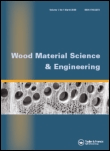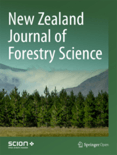
WOOD SCIENCE AND TECHNOLOGY
Scope & Guideline
Exploring Innovations in Forestry and Materials Science
Introduction
Aims and Scopes
- Wood Properties and Performance:
Research in this area investigates the physical, mechanical, and chemical properties of various wood species, examining how these properties affect their performance in different applications. - Wood Modification Techniques:
Studies focus on various methods to enhance wood properties, including thermal modification, chemical treatments, and the use of bio-based additives to improve durability, stability, and resistance to biological degradation. - Sustainable Wood Utilization:
The journal emphasizes the importance of sustainable practices in wood production and utilization, including studies on bio-based materials, recycling, and the use of wood in green building practices. - Wood Processing and Technology:
Research on the processing techniques of wood, including sawing, drying, and adhesive bonding, with a focus on optimizing production methods and improving quality control. - Biomaterials and Bioenergy:
Explorations into the application of wood and lignocellulosic materials in the production of biofuels, bioplastics, and other bio-based materials, highlighting their potential in the circular economy. - Wood Protection and Preservation:
Studies related to the protection of wood from environmental factors and biological threats, including the development of preservatives and treatment methods to extend the lifespan of wood products.
Trending and Emerging
- Nanotechnology and Wood Composites:
There is an increasing trend towards the incorporation of nanomaterials in wood composites to enhance physical and mechanical properties, showcasing innovative approaches to material design. - Digital and Smart Technologies in Wood Science:
Emerging themes include the use of digital tools such as machine learning and imaging techniques for quality control, defect detection, and process optimization in wood processing. - Environmental Impact and Life Cycle Assessment:
Research focusing on the environmental footprint of wood products and the life cycle assessment of wood utilization is gaining importance as sustainability becomes a central theme in wood science. - Bio-based and Biodegradable Materials:
An increasing emphasis on developing bio-based materials from wood and lignocellulosic sources for applications in packaging, construction, and consumer products reflects the shift towards sustainability. - Wood-water Interactions and Moisture Management:
Emerging studies are focusing on the complex interactions between wood and moisture, emphasizing the importance of understanding these dynamics for improving wood performance in varying environmental conditions.
Declining or Waning
- Traditional Wood Species Studies:
Research focusing on common wood species has decreased, as there is a growing interest in exploring lesser-known species or engineered wood products that offer new properties and applications. - Conventional Wood Preservation Methods:
The focus on traditional chemical preservatives is declining, giving way to more sustainable and environmentally friendly alternatives, such as natural preservatives and biomaterials. - Basic Wood Anatomy and Morphology:
While still relevant, studies solely centered around the basic anatomical and morphological characteristics of wood have become less frequent compared to more applied research that links anatomy to performance and technology. - Historical Wood Usage and Applications:
Research examining the historical aspects of wood use in traditional crafts and architecture is waning, as the field shifts towards innovative applications and modern technologies.
Similar Journals

Kastamonu University Journal of Forestry Faculty
Enhancing scientific discourse in forestry and environmental stewardship.Kastamonu University Journal of Forestry Faculty, published by KASTAMONU UNIV, is a prestigious open-access journal dedicated to advancing knowledge in the field of forestry and environmental sciences. Established in 2001, this journal provides a vital platform for researchers, professionals, and students to share their findings and insights on topics such as sustainable forest management, ecological restoration, and forestry education. Its commitment to open access ensures that groundbreaking research is readily available to a global audience, fostering collaboration and innovation in the field. Although specific metrics such as HIndex are currently not available, the journal continues to strive towards increasing its visibility and impact within academic circles. With a strong focus on promoting scholarly exchange, the Kastamonu University Journal of Forestry Faculty plays a crucial role in enhancing the scientific discourse surrounding forestry issues at both local and international levels.

Lesnoy Zhurnal-Forestry Journal
Connecting Global Scholars for Sustainable Forestry SolutionsLesnoy Zhurnal-Forestry Journal is a prominent academic publication dedicated to advancing the field of forestry and environmental sciences. Published by the Northern Arctic Federal University M. V. Lomonosov, this journal focuses on innovative research, practices, and policies related to forestry management and conservation. With an Open Access model established since 2015, the journal ensures widespread dissemination of knowledge and foster collaborative research across global scholarly communities. Located in Arkhangelsk, Russia, the Lesnoy Zhurnal appeals to researchers, professionals, and students alike, providing a platform for sharing valuable insights and addressing emerging challenges in forestry. Though specific metrics like HIndex and Scopus rankings are presently unlisted, the journal is committed to excellence and aims to enhance its visibility and impact within the scientific community. This publication is not only a critical resource for ongoing research but a key player in shaping sustainable forestry practices in a rapidly changing environment, making it indispensable for anyone involved in forestry and environmental studies.

CANADIAN JOURNAL OF FOREST RESEARCH
Connecting researchers to the heart of forest science.Canadian Journal of Forest Research (ISSN: 0045-5067, E-ISSN: 1208-6037), published by Canadian Science Publishing, stands as a leading platform for disseminating cutting-edge research in the field of forestry and ecological sciences. With an impressive impact factor and a steady reputation for high-quality publications, this journal occupies a prestigious position indicated by its Q1 ranking in Forestry and Q2 in Ecology as of 2023, alongside commendable placements in global and planetary change studies. Covering a broad scope from sustainable forest management to the impacts of climate change on forest ecosystems, the journal encourages submissions that address contemporary challenges and innovations in forest research. Operating from its base in Ottawa, Canada, the Canadian Journal of Forest Research has been a cornerstone of academic discourse since 1974, offering researchers and professionals vital access to pioneering studies that inform policy and practice in forestry. Researchers, educators, and students alike will find this journal an indispensable resource for advancing knowledge and fostering collaboration in the vital realm of forest research.

Maderas-Ciencia y Tecnologia
Empowering knowledge in wood engineering and technology.Maderas-Ciencia y Tecnologia, published by UNIV BIO-BIO in Chile, is a prestigious open-access journal dedicated to advancing knowledge in the fields of Forestry, Chemical Engineering, and Materials Science. With an ISSN of 0717-3644 and an E-ISSN of 0718-221X, this journal has been serving the academic community since 2005, providing a platform for research that spans multiple disciplines including Industrial and Manufacturing Engineering. Recognized for its scholarly contributions, Maderas-Ciencia y Tecnologia achieves a commendable Q2 ranking in Forestry and several Q3 rankings in associated fields such as Chemical Engineering and Materials Science as of 2023. The journal aims to foster innovation and collaboration by publishing high-quality research articles that address pressing issues in wood engineering and technology, appealing to researchers, professionals, and students alike. With a strong commitment to open access, all content is readily available to a global audience, ensuring the widespread dissemination of knowledge and fostering advancements within these critical areas.

IAWA JOURNAL
Innovating Insights for a Greener TomorrowIAWA JOURNAL is a distinguished academic publication dedicated to the fields of forestry and plant science, published by BRILL, a reputable name in scholarly publishing. With an ISSN of 0928-1541 and an E-ISSN of 2294-1932, the journal has garnered impressive rankings within Scopus, placing 48th in Forestry and 182nd in Plant Science, indicating its strong influence and relevance in these scientific areas. Operating from the Netherlands, the IAWA JOURNAL focuses on a broad scope of research themes, contributing to the advancement of knowledge from its inception in 1980 and continuing robustly through to 2024. With a Category Quartile of Q2 in Forestry and Q3 in Plant Science as of 2023, the journal serves as a vital resource for researchers, professionals, and students alike, facilitating the exchange of innovative ideas and significant findings in the plant biology community. Although the journal does not currently offer open access, it remains a pivotal platform for disseminating high-quality research that shapes the future of the ecological and environmental sciences.

JOURNAL OF TROPICAL FOREST SCIENCE
Bridging Research and Practice in Tropical ForestryThe JOURNAL OF TROPICAL FOREST SCIENCE, published by the FOREST RESEARCH INST MALAYSIA, serves as a vital platform for disseminating research focused on tropical forestry. Since its inception in 1988 and transitioning to its current form in 1993, this journal has established itself within the academic community, currently holding a commendable Q3 ranking in the Forestry category, as per the 2023 metrics. With an ISSN of 0128-1283 and E-ISSN 2521-9847, it provides crucial insights into the ecological, economic, and social aspects of tropical forest management and conservation, making it an indispensable resource for researchers, practitioners, and students alike. Although it does not operate under an open-access model, the journal emphasizes quality and relevance in its publications, contributing significantly to the ongoing discourse in agricultural and biological sciences with a Scopus rank of #89 out of 174 and a 49th percentile position.

Drewno
Connecting Minds in Forestry and Manufacturing EngineeringDrewno is an esteemed, peer-reviewed Open Access journal dedicated to advancing knowledge in the fields of Biomaterials, Forestry, and Industrial and Manufacturing Engineering. Published by the Institute of Wood Technology in Poland, the journal has been an invaluable resource for researchers and practitioners alike since its inception in 2009. With an impact factor reflected in its notable rankings—Q4 in Biomaterials, Q3 in both Forestry and Industrial and Manufacturing Engineering—it offers a unique platform for disseminating groundbreaking research and innovative practices.
As a fully Open Access journal since 2021, Drewno ensures that its content is freely accessible, promoting widespread dissemination of knowledge within the academic community and beyond. Situated at the crossroads of engineering and biological sciences, it serves as a critical conduit for collaborative research and development. Researchers, professionals, and students are encouraged to contribute and engage with the vital discussions shaping the future of material sciences and sustainable forest management.

Wood Material Science & Engineering
Transforming Research into Sustainable PracticesWood Material Science & Engineering, published by Taylor & Francis Ltd, is a pivotal journal in the field of materials science, focusing specifically on the intricate properties, performance, and applications of wood-based materials. With an ISSN of 1748-0272 and an E-ISSN of 1748-0280, this journal has established itself as a valuable resource for researchers and professionals working in the interdisciplinary domains of material science and engineering related to wood. Since its inception in 2006, the journal has seen continual growth, with its 2023 Scopus Rank placing it in the 49th percentile among general materials science journals. Although listed in Q3 of the materials science category, it plays a crucial role in facilitating innovative research and applications of wood materials, thereby significantly influencing sustainable practices in engineering and design. The journal invites original research articles, reviews, and case studies to further the understanding of wood materials, making it an ideal platform for scholars and practitioners dedicated to advancing material science. For researchers looking to disseminate their findings to a global audience, Wood Material Science & Engineering promises a dedicated avenue for impactful communication.

JOURNAL OF WOOD CHEMISTRY AND TECHNOLOGY
Fostering Innovative Approaches in Wood TechnologyJournal of Wood Chemistry and Technology, published by Taylor & Francis Inc, is a premier academic platform dedicated to advancing the fields of wood chemistry and technology since its inception in 1981. With an impressive converged publication run extending through 2024, this journal addresses pivotal research in chemical engineering and materials science, achieving a current categorization in Q2 for both Chemical Engineering and Chemistry, alongside a Q3 ranking in Materials Science. As evidenced by its Scopus rankings, it occupies a respectable position within the academic community, fostering discussions that bridge theoretical innovation and practical applications relevant to the industry. While access is not open, the journal remains an essential resource for researchers, professionals, and students eager to explore the complexities of wood chemistry, enhancing their understanding and contributing to sustainable practices in materials development.

NEW ZEALAND JOURNAL OF FORESTRY SCIENCE
Pioneering Research in Ecology and Plant SciencesNEW ZEALAND JOURNAL OF FORESTRY SCIENCE (ISSN: 0048-0134; E-ISSN: 1179-5395), published by SCION, stands as a pivotal resource for researchers, professionals, and students dedicated to the fields of forestry, ecology, and plant sciences. With a strong commitment to open access since 2013, the journal promotes the dissemination of high-quality research and innovative practices within these disciplines, thereby fostering a greater understanding of the natural environment. The journal has achieved commendable rankings, being placed in the Q2 category in Ecology, Forestry, and Plant Science, reflecting its significant contribution to advancing knowledge and best practices in these areas. Based in Switzerland and published by SCION, a trusted name in forest research, the journal plays an integral role in shaping the dialogue around sustainable forest management and ecological conservation. As such, it serves as an essential platform for scholarly discourse and a valuable resource for anyone engaged in forestry and environmental studies.